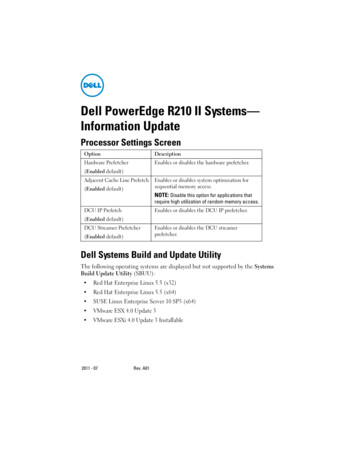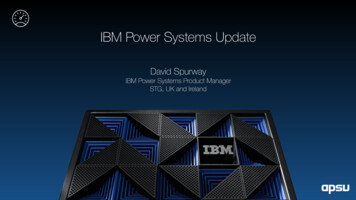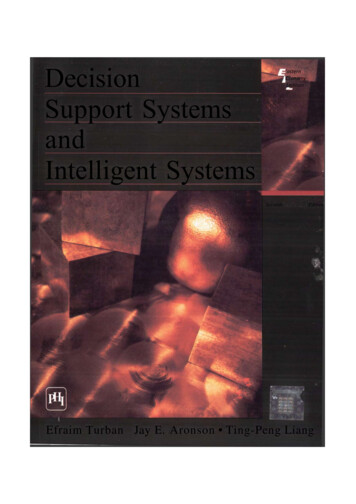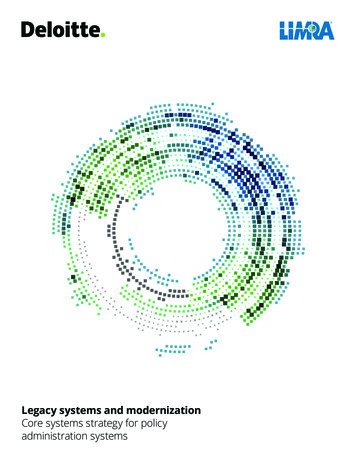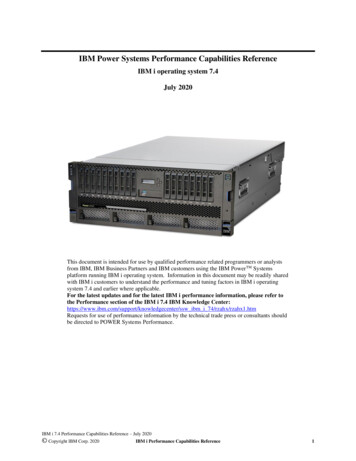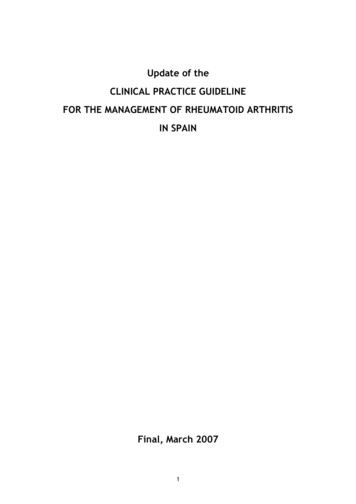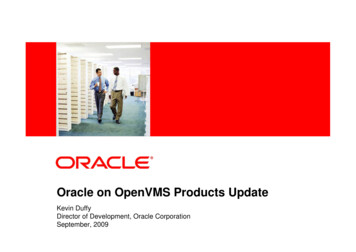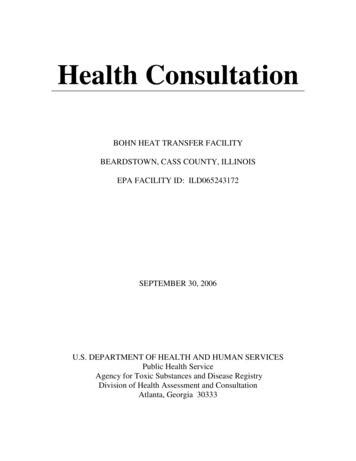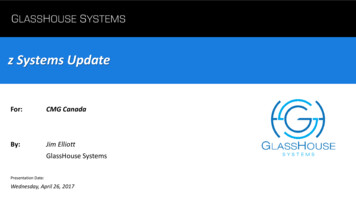
Transcription
z Systems UpdateFor:CMG CanadaBy:Jim ElliottGlassHouse SystemsPresentation Date:Wednesday, April 26, 2017
Agenda IBM z13s/LinuxONE Rockhopper IBM zNext MR Implications – Coupling Link Changes IBM Dynamic Partition Manager Linux and Blockchain on IBM z Systems Managing IBM z/OS Software Charges IBM z/OS 2.3 PreviewGlassHouse Systemsz Systems Update for CMG Canada2017-04-26Page 2
IBM z13s andLinuxONE RockhopperGlassHouse Systemsz Systems Update for CMG Canada2017-04-26Page 3
The IBM z13s/LinuxONE RockhopperMachine Type: 2965 Models: N10/L10 and N20/L202965IBM z13s ModelsN10/N20IBM LinuxONERockhopper 20/L201 CPCDrawer202008GBN20/L202 CPCDrawers204056GBGlassHouse SystemsPerformance andscale helpingimprove clientexperienceFocused onenterprise Linux Up to 20 configurable coresLarger cache for improved data servingNew SIMD vector facility for faster mathematical computationUp to 4 TB memory to reduce latency (8X more than zBC12)Simultaneous multithreading expands zIIP and IFL capacityIndustry-leading resilient and intelligent I/OImproved network-in-a-box communications Continuous data availability for z/OS and Linux guests hosted by z/VM with new GDPSAppliance IBM Dynamic Partition Manager simplifies managementBetter Economics,Flexibility andEfficiency 40% more total z/OS capacity110% more total Linux capacity1.3x more logical partitions to host more cloud tenants (40 vs. 30)4x data access with zEDCRack mounted HMC and TKELowering costs and raising RAS with ASHRAE A3 envelopeFortified cybersecurity for lessrisk Improved recovery time using zHPFInsure protection and integrity with next generation cryptographyNew PCIe based short range coupling linksSecure deployment of software virtual appliancesz Systems Update for CMG Canada2017-04-26Page 4
z13s Model N20 (One CPC Drawer) – Under the CoversSupport ElementsInternalBatteriesEthernet cables for internal SystemLAN connecting Flexible ServiceProcessor (FSP) cage controllercards (not shown)(optional)PowerSuppliesSCH (x2)1 x CPC Drawer slotfor 2nd CPC DrawerMemory & FanoutsMonitors keyboards forSEsPCIe I/ODrawersNote: A 2 CPC drawer N20can only support a maximumof 2 PCIe I/O Drawers OR onePCIe I/O Drawer and one I/ODrawerI/O DrawerRear ViewGlassHouse SystemsFront Viewz Systems Update for CMG Canada2017-04-26Page 5
2965 Processor Unit (PU) Chip Details 14S0 22nm SOI Technology‒ 17 layers of metal‒ 3.99 Billion Transistors‒ 13.7 miles of copper wire Chip Area‒ 678.8 mm2 / 28.4 x 23.9 mm‒ 17,773 power pins‒ 1,603 signal I/OsGlassHouse Systems 6 or 7 active cores (PUs) per chip on 2965 (designed with 8 cores total)‒ 4.3 GHz (vs. 4.2GHz for zBC12)‒ L1 cache / core, 96 KB I-cache / 128 KB D-cache‒ L2 cache / core, 2M i 2M d Byte eDRAM split private L2 cache Single Instruction/Multiple Data (SIMD) Single thread or 2-way simultaneous multithreading (SMT) operation Improved instruction execution bandwidth:‒ Greatly improved branch prediction and instruction fetch to support SMT‒ Instruction decode, dispatch, complete increased to 6 instructions per cycle‒ Issue up to 10 instructions per cycle‒ Integer and floating point execution units On chip 64 MB eDRAM L3 Cache‒ Shared by all cores I/O buses‒ One InfiniBand I/O bus‒ Two PCIe I/O buses Memory Controller (MCU)‒ Interface to controller on memory DIMMs‒ Supports RAIM designz Systems Update for CMG Canada2017-04-266Page 6
2965 Model N10/L10 CPC Drawer (Top View)Node 0FrontNode 1 Model supports a single Node (Node 0) Each Node Supports:‒ One System Control (SC) chip (480 MB L4 cache)‒ Two Processing Units (PU) chips running at 4.3 GHzSCSCMPUPUSCM SCMGlassHouse Systems Eight-core per PU chip design Six or seven active cores per PU chip‒ One memory controller per PU chip (two per node)‒ Five DDR3 DIMM slots per memory controller: 10total per node (up to 1024 GB per node)‒ Two Flexible Service Processors‒ Four PCIe fanout slots‒ Two slots for IFB (HCA3-O) fanoutsz Systems Update for CMG Canada2017-04-26Page 7
Performance delivered through multiple dimensions1 Hardware Software‒ 40% more total z/OS capacity ‒Faster decision making with‒ 110% more total Linuxdata-in-memorycapacity‒Less exposure to regulatory‒ 2.3x performance boost forpenaltiescryptographic coprocessors‒Hundreds of production‒ Up to 1.5x improvement forcapable virtual machinesgeneric apps with Java8 using‒Faster data sharing betweenSIMD and SMTsystems‒ 1.5x-1.8x more bandwidth‒More scale for mobileper I/O domain‒ 2x increase in channel speedtransactions‒ 8x increase in memory‒Faster fraud detection‒ 2x increase in cache‒Lower cloud cost1 Comparison tozBC12. Official performance data will be available upon announce and can be obtained online at LSPR (Large Systems Performance Reference) website sf/pages/lsprindex. Actual performance results may vary by customer based on individual workload, configuration and software levels.GlassHouse Systemsz Systems Update for CMG Canada82017-04-26Page 8
IBM z Systems Single Frame ComparisonzBC12 (2828) H06zBC12 (2828) H13z13s (2965) N20/L20(1)z13s (2965) N10/L10Uniprocessor Performance1064 MIPS1430 MIPS ( 34%)Frequency4.2 GHz4.3 GHzz/OS Capacity50 to 4958 MIPS80 to 7123 MIPSTotal System Memory240 GB496 GB1TB4TBConfigurable Specialty Engines6131020Configurable CPs0–60 to 6LPARS/LCSS30/240/3HiperSockets32PCIe I/O drawer, I/O drawer, Max322, 1, 32, 1, 31, 1, 2(2)2, 1, 3 (2)I/O slots per I/O drawers/ PCIe I/O drawers8/328/32FICON Channels12864(3)128(3)OSA Ports9664(3)96(3)ESCON Channels0(4)0(4)IFB host bus Bandwidth,PCIe Bandwidth6.0 GB/sec (IFB),8.0 GB/sec (PCIe Gen2)6.0GB/sec(IFB),16.0 GB/sec (PCIe Gen3)ISC-3, PSIFB, PCIe32, 8 -16, 032, 16- 32, 00(5), 4-8(6), 80(5), 16-32(7), 16zIIP/zAAP Maximum QtyUp to 4 / 3Up to 8 / 6Up to 6(8) / 0Up to 12(8) / 0ICF Maximum Qty6131020Capacity Settings156156156156UpgradeableGlassHouse SystemsH06 to H13, H13 to zEC12 H20(Radiator-based air cooled only) or to z13sz Systems Update for CMG CanadaN10 to N20, N20 to z13 N30(Radiator-based air cooled only)2017-04-26Page 9
Continuing the CMOS Mainframe heritageGlassHouse Systemsz Systems Update for CMG Canada2017-04-26Page 10
IBM z Systems GenerationsN-4N-3N-2N-1z9 Enterprise Class Announced 7/2005 1.7 GHz Up to 54 cfg cores CP, IFL, ICF, zAAP, zIIP Up to 512 GB Memoryz10 Enterprise Class Announced 2/2008 4.4 GHz Up to 64 cfg cores CP, IFL, ICF, zAAP, zIIP Up to 1.5 TB MemoryzEnterprise 196 Announced 7/22/2010 5.2 GHz Up to 80 cfg cores CP, IFL, ICF, zAAP, zIIP Up to 3 TB MemoryzEnterprise EC12 Announced 8/28/2012 5.5 GHz Up to 101 cfg cores CP, IFL, ICF, zAAP, zIIP Up to 3 TB Memoryz9 Business Class Announced 4/2006 1.4 GHz Up to 7 cfg cores CP, IFL, ICF, zAAP, zIIP Up to 64 GB Memoryz10 Business Class Announced 10/2008 3.5 GHz Up to 10 cfg cores (5 CP) CP, IFL, ICF, zAAP, zIIP Up to 248 GB MemoryzEnterprise 114 Announced 7/12/2011 3.8 GHz Up to 10 cfg cores (5 CP) CP, IFL, ICF, zAAP, zIIP Up to 248 GB MemoryzEnterprise BC12 Announced 7/23/2013 4.2 GHz Up to 13 cfg cores (6 CP) CP, IFL, ICF, zAAP, zIIP Up to 496 GB MemoryGlassHouse Systemsz Systems Update for CMG CanadaNIBM z13 Announced 1/14/2015 5.0 GHz Up to 141 cfg cores CP, IFL, ICF, zIIP Up to 10 TB MemoryIBM z13s Announced 2/16/2016 4.3 GHz Up to 20 cfg cores (6 CP) CP, IFL, ICF, zIIP Up to 4 TB Memory2017-04-26Page 11
z13s Capacity pecialtyEngineSpecialtyEngineSpecialtyEnginePCI: Processor Capacity IndexGlassHouse Systems Improvement over zBC12‒ A01 Uniprocessor: 80 MIPS ( 60%)‒ Z01 Uniprocessor: 1,430 MIPS ( 34%)‒ Z06 provides largest z/OS capacity: 7,123 MIPS ( 44%) Granularity levels similar to zBC12 to facilitate upgrades andincremental growth 26 capacity levels x 6 CPs 156 settings‒ Nomenclature: XYY‒ X Capacity level (A-Z)‒ YY Number of processors‒ A00 ICF or IFL only (zero CPs) Any to any capacity upgrade/downgrade capability within the Model CBU capability from smallest to largest capacities within the Model On/Off CoD within the Model IFLs, ICFs, and zIIPs are always “Znn” capacity Available MIPS are always less than the theoretical MIPS as a result ofthe desired tyEngineSpecialtyEngineAdditional PUs available on the N10/N20 10 more specialty enginesAdditional PUs available on the N20z Systems Update for CMG Canada2017-04-26Page 12
Balanced System DesignGlassHouse Systemsz Systems Update for CMG Canada2017-04-26Page 13
What Is New in the 2965? The 2965 has ultra-high frequency, large high-speed buffers (caches) and memory,superscalar processor design, out-of-order core execution, simultaneous multithreading(SMT), single-instruction multiple-data (SIMD) execution, and flexible configuration options– it is the next implementation of z Systems to address the ever-changing IT environment The microprocessor of 2965 has the same design as 2964, the difference is the frequency –4.3 GHz vs. 5 GHz for 2964 The drawer packaging is also derived from 2964, where the 2965 PU chips are air cooled (vs.water cooled for 2964) as the lower frequency generates less heat 2965 has several microprocessor improvements upon zBC12:‒ Higher instruction execution parallelism (improved OOO instruction handling)‒ Two vector execution units (SIMD)‒ Simultaneous multithreaded (SMT) architecture that supports concurrent execution of twothreads‒ Eight-core processor chip (6 or 7 cores per chip will be used with 2965)‒ A robust cache hierarchy Benefits:‒ Performance gains in legacy online transaction processing and business analytics workloads.GlassHouse Systemsz Systems Update for CMG Canada2017-04-26Page 14
Simultaneous Multithreading (SMT) Prior z Systems generations support a single instruction stream‒ z Systems workloads tend to receive a nontrivial number of cache misses‒ CPU generally unproductive while resolving cache miss z13/z13s SMT makes PU Core productive during cache misses and fills other pipeline gaps‒ z13/z13s supports two way SMT (two instruction streams [threads]) per core Each thread has its own unique state information (Registers, PSW, etc.) Cannot necessarily execute instructions instantly and must compete and win the use of desired core resources shared betweenthreads z13/z13s insures that one thread can’t lock out the other‒ Current z13/z13s implementation allows following engine types to run in SMT mode zIIPs under z/OS, IFLs under z/VM or Linux on z Systems‒ READY TO RUN Threads share core‒ Threads NOT READY TO RUN still unproductive while resolving cache miss‒ Core resources are productive when either READY TO RUN thread is executingGlassHouse Systemsz Systems Update for CMG Canada2017-04-26Page 15
Single Instruction Multiple Data (SIMD) Background‒ The amount of data is increasing exponentially, IT shops need to respond tothe diversity and volume of data‒ Enterprises use traditional integer, floating point, string, and XML characterbased data‒ It’s becoming more important for customers to do computations, analyticscloser to the data Customer perception of Analytics and z Systems‒ z Systems handle OLTP and Batch jobs types of workload‒ Mathematical and data intensive operations can lead to unaffordable MIPSusage Reality of Analytics and z Systems‒ For the past 2-3 generations, z Systems processor has changed its capabilities incompute-intensive processing (analytics)‒ SIMD provides next phase of enhancements for analytics and computeintensive competitiveness on z SystemsGlassHouse Systemsz Systems Update for CMG Canada2017-04-26Page 16
SIMD Vector Processing Support on z Systems Operating Systems / Hypervisors and Software support for SIMD:‒z/OS V2.2, or z/OS: 2.1 PTFs‒Linux: Supported in the latest updates from Red Hat RHEL, SUSE LabsSLES, and Canonical UbuntuWorkloads‒z/VM 6.4, or z/VM V6.3 PTFsJava 8C/C Compiler built-insMASS & ATLAS‒Compiler exploitationfor SIMD operationsMath Libraries IBM Java 8 z/OS XL C/C V2R1M1, V2.2(added AUTOSIMD option) XL C/C for Linux on z Systems, V1.1 Enterprise COBOL for z/OS v5.2 Enterprise PL/I for z/OS v4.5SIMD Registers and Instruction SetMASS - Mathematical Acceleration Sub-SystemATLAS - Automatically Tuned Linear Algebra SoftwareGlassHouse Systemsz Systems Update for CMG Canada2017-04-26Page 17
Model N10/L10 Drawer Structure and InterconnectPartially Populated DrawerMemMemPUPUGX Bus2 PCIePSIGX Bus2 PCIePSIX-BusSCNode 1Node 0 Note: Both z114 and zBC12 have onenode per CPC drawer with two PU SCMs,five DIMMs per PU SCM and one SystemControl SCM. The PU SCM L3 Caches arenot connected directly. L4 cache design isinclusive of the L3s.GlassHouse SystemsOne Physical node Chips‒ Two PU chips, One SC chip Redundant array of independentmemory (RAIM) Memory‒ Two Memory Controllers: One perPU‒ Five DDR3 DIMM slots per PU ChipMemory Controller‒ Populated DIMM slots: 10 SC and PU Chip Interconnects‒ SC and PU Chip Interconnects‒ X-bus: SC L4 and CP L3s to eachother (same node)z Systems Update for CMG Canada2017-04-2618Page 18
z13s Model N20 Drawer Structure and InterconnectFully Populated DrawerMem DIMMsMemPUPUGX Bus2 PCIeGX BusGX Bus2 PCIePSI2 PCIePSIX-BusMemMemPUPUGX Bus2 PCIePSIX-BusSCNode 1S-BusSCNode 0 Note: Both z114 and zBC12 have onenode per CPC drawer with two PU SCMs,five DIMMs per PU SCM and one SystemControl SCM. The PU SCM L3 Caches arenot connected directly. L4 cache design isinclusive of the L3s.GlassHouse SystemsTwo Physical Nodes Chips‒ Two PU chips per node‒ One SC chip per node RAIM Memory‒ Four Memory Controllers: One perPU‒ Five DDR3 DIMM slots per PU chipMemory Controller‒ Populated DIMM slots: 10 or 20 SC and CP Chip Interconnects‒ X-bus: SC L4 and CP L3s to eachother (same node)‒ S-bus: SC L4 to SC L4 in the drawerz Systems Update for CMG Canada2017-04-2619Page 19
z Systems Cache Topology – zBC12 vs. z13sL4 Caches2 L4 Caches192MBShared eDRAM L424MB ShreDRAM L3L2L1L2 L2L1 L1L1:L2L1224MB NICDirectory24MB ShreDRAM L3L2L1L2L1L2L1L2L1L2L1L2 L2L1 L164MB ShreDRAM L3L2 L2 L2 L2 L2L1 L1 L1 L1 L1L2Private 1MB Inclusive of DL1Private 1MB Inclusive of IL112w Set Associative256B cache line sizeL3Shared 24MB Inclusive of L2s12w Set Associative256B cache line sizeL4Intra-node InterfaceL2L164KI 96KD6w DL1, 4w IL1256B line size192MB Inclusive24w Set Associative256B cache line sizeL2L164MB ShreDRAM L32 L3s and13 L1 / L2sL2L1L2 L2 L2 L2L1 L1 L1 L1L2L1L1:96KI 128KD8w DL1, 6w IL1256B line sizeL2Private 2MB Inclusive of DL1Private 2MB Inclusive of IL1L3Shared 64MB Inclusive of L2s16w Set Associative256B cache line sizeL4480MB 224MB Non-Data Inclusive CoherentDirectory30W Set Associative256B cache line sizezBC12GlassHouse Systems480MBShared eDRAM L4z Systems Update for CMG CanadaL2L1Note: Not all 8cores are usedin z13s. 6/7 coresper PU chip areactive.z13s node2017-04-26Page 20
Processor options and memoryModelDrawers paresIFPMax.MemoryN101/130-60-100-60-1020-201984 GBL101/130-10-100020-201984 GBN201/260-60-200-120-2030-3212008 GBL201/260-10-200030-3212008 GBN20 2/260-60-200-120-2030-3214056 GBL20 2/260-10-200030-3214056 GB On models L10/L20 there can be only one CP at capacity setting C01 which may only be used for the GDPSappliance L10/L20 models have a different cover from the N10/N20 models N20/L20 models are a one- or two- drawer system with same processor feature counts for both configurations N20/L20 – second drawer is added when additional fanouts (N20) or more than 2008 GB memory are needed The maximum number of logical ICFs or logical CPs supported in a CF logical partition is 16 The integrated firmware processor (IFP) is used for native PCIe I/O support functions Upgrades from N10/L10 to N20/L20 and N20/L20 to N20 /L20 are disruptive SMT is supported with processor types IFL and zIIPGlassHouse Systemsz Systems Update for CMG Canada2017-04-26Page 21
Model N10/L10 MemoryN10 Physical Memory RAIM GBAddressable Memory GBClientGBIncrementGB32 RAIM (2 x 16GB) - 128 for HSA (40) Client (88)64728088864 RAIM (2 x 32GB) - 256 for HSA (40) Client (216)12015218421632128 RAIM (2 x 64GB) - 384 for HSA (40) Client (344)24828031234432 Plan Ahead Memory can be addedto eliminate disruption128 RAIM (2 x 64GB) - 512 for HSA (40) Client (472)40847264256 RAIM (2 x 128GB) - 640 for HSA (40) Client (600)53660064256 RAIM (2 x 128GB) - 1024 for HSA (40) Client (984)728856984128 On both models, memoryupgrades within each row (samecolor) are concurrent withoutadding Plan Ahead MemoryGlassHouse Systems 2965 has the same RAIM Memoryinfrastructure as zBC12 Minimum client memory is 64 GB HSA is 40 GB (vs. 16 GB onzBC12) Memory upgrades that requireDIMM changes are disruptivez Systems Update for CMG Canada2017-04-26Page 22
Large Memory – Potential Performance Gains Potential latency reductionfor OLTP workloads‒ Response time reductions‒ Increased transaction rates Enables in-memorydatabases‒ Dramatic reduction inresponse time by avoidingI/O wait Batch window reduction‒ More concurrent workloads‒ Shorter elapsed times forjobsGlassHouse Systems Reducing time to insight for analytic workloads‒ Process data more efficiently – keep pace withinflux of data‒ Reduces time to get from raw data to businessinsight CPU performance improvements‒ Improves response time and shrinks batchwindows‒ Reduce the need for application/systemredesign to meet service goals‒ Reduction in CPU time per transaction Run more work at the same hardware and softwareMSU rating -or Run the same workload with lower hardware andsoftware MSU ratingz Systems Update for CMG Canada2017-04-2623Page 23
References on Large Memory Exploitation z/OS Infrastructure Optimization using Large 6.html Benefits of Configuring More Memory in the IBM z/OS Software .html Advantages of Configuring more DB2 Buffer sf/WebIndex/WP102464 SAP memory white sf/WebIndex/WP102461GlassHouse Systemsz Systems Update for CMG Canada2017-04-26Page 24
I/O features supported PCIe drawer‒ FICON Express16S (SX and LX, 2 SFPs, 2 CHPIDs) at 16 Gbps, 8 Gbps, 4 Gbps‒ FICON Express8S (SX and LX, 2 SFPs, 2 CHPIDs) at 8 Gbps, 4 Gbps, 2 Gbps‒ OSA-Express5S 10 GbE LR and SR (1 SFP, 1 CHPID) GbE SX, LX, and 1000BASE-T (2 SFPs, 1 CHPID)‒ 10 GbE RoCE Express (2 supported SR ports)‒ zEDC Express‒ Crypto Express5S‒ Flash Express‒ Integrated Coupling Adapter (ICA) – ICA SR two 8 GBps PCIe Gen3 Coupling Link(and future DS8880 Hyperlink) Processor drawer‒ InfiniBand Coupling fanouts HCA3-O two 12x 6GBps InfiniBand DDR Coupling Links HCA3-O LR four 1x 5Gbps InfiniBand DDR or SDR Coupling LinksGlassHouse Systemsz Systems Update for CMG Canada2017-04-26Page 25
I/O Subsystem Internal Bus Interconnect SpeedsGlassHouse Systemsz Systems Update for CMG Canada2017-04-26Page 26
FICON Express16S – SX and 10KM LX For FICON, zHPF, and FCP environments‒ CHPID types: FC and FCP (Two PCHIDs/CHPIDs) Auto-negotiates to 4, 8, or 16 Gbps‒ 2Gbps connectivity NOT supported4, 8, 16‒ FICON Express8S will be available to order for 2Gbps connectivityGbps Increased I/O Devices (subchannels) per channel for all FICON fea
The IBM z13s/LinuxONE Rockhopper Machine Type: 2965 Models: N10/L10 and N20/L20 z Systems Update for CMG Canada 2017-04-26 Page 4 2965 IBM z13s Models N10/N20 IBM LinuxONE Rockhopper Models L10/L20 Model Customer PUs Max Mem N10/L1



